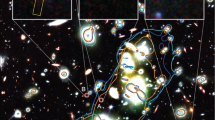Abstract
Mid-infrared imaging photometry of the Orion BN/KL infrared cluster at eight wavelengths between 5 and 20µm using a 58 × 62 pixel imaging array camera has revealed new compact sources and the large-scale structure of the region in diffraction-limited (1 arcsec) detail. Several new objects have been detected within a few arcsec of IRc2, widely thought to be the principal luminosity source for the entire BN/KL complex. Detailed color temperature and emission opacity images are derived from the 7.8, 12.4 and 20.0µm observations, and the 9.8µm image is used to derive an image of “silicate” dust extinction for the region. The color temperature, opacity, and extinction images show that IRc2 may not be the single dominant luminosity source for the BN/KL region; substantial contributions to the luminosity could be made by IRc7, BN, KL, and five new compact 10µm sources detected within a few arcseconds of IRc2. We suggest that a luminous, early-type star near IRc2, which is associated with the compact radio source “I” and the Orion SiO maser, is the dominant luminosity source in the BN/KL region, hidden from view by cool dust material with at least Av ∼ 60 mag of visible extinction.
Similar content being viewed by others
Author information
Authors and Affiliations
Rights and permissions
About this article
Cite this article
Gezari, D.Y., Backman, D.E. 4.8 – 20 micron imaging of orion BN/KL: luminosity sources and the role of IRc2. Astrophys Space Sci 224, 463 (1995). https://doi.org/10.1007/BF00667906
Issue Date:
DOI: https://doi.org/10.1007/BF00667906




